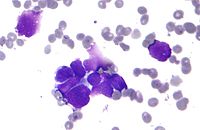
Photo from wikipedia
Fine‐needle aspiration (FNA) is a minimally invasive and effective modality to diagnose pancreatic ductal adenocarcinoma. However, some histologic subtypes of ductal adenocarcinoma are rarely encountered and challenging to diagnose on… Click to show full abstract
Fine‐needle aspiration (FNA) is a minimally invasive and effective modality to diagnose pancreatic ductal adenocarcinoma. However, some histologic subtypes of ductal adenocarcinoma are rarely encountered and challenging to diagnose on FNA/small biopsies. To date, cytohistologic features of pancreatic sarcomatoid undifferentiated carcinoma with heterologous elements have not been thoroughly described. An 83‐year‐old man with lower back pain was found to have an incidental pancreatic neck mass. FNA biopsy of the mass showed rare markedly atypical, large, pleomorphic cells in a background of abundant calcifications/bone formation without areas of conventional adenocarcinoma. A diagnosis of “Malignant neoplasm with osteosarcomatous differentiation” was rendered on the FNA specimen. Subsequently, a Whipple resection revealed a 4.1 cm lobulated, calcified pancreatic mass. Microscopic examination showed a heavily calcified/ossified mass with adjacent areas of a highly cellular malignant spindle cell proliferation and admixed large, pleomorphic tumor cells; no background conventional adenocarcinoma was identified. Cytokeratin immunostains MNF116 and CK19 were positive in a large subset of the malignant spindle cells, and AE1.3/CAM5.2 showed patchy weak staining. Molecular testing revealed mutations in KRAS, TP53, BRCA2, NTRK3, EPHA2, MYD88, and CBL. No reportable fusions were detected. The final diagnosis was “Sarcomatoid undifferentiated carcinoma with heterologous elements (osteosarcomatous differentiation).” Definitive diagnosis of extremely rare subtypes of ductal adenocarcinoma is challenging on FNA biopsies. In this case, cytologic evaluation was helpful in making an early diagnosis of a malignant neoplasm with highly unusual features, prompting appropriate triage and early surgical resection of a sarcomatoid undifferentiated carcinoma with prominent osteosarcomatous differentiation.
Journal Title: Diagnostic Cytopathology
Year Published: 2023
Link to full text (if available)
Share on Social Media: Sign Up to like & get
recommendations!